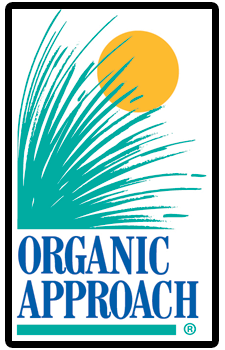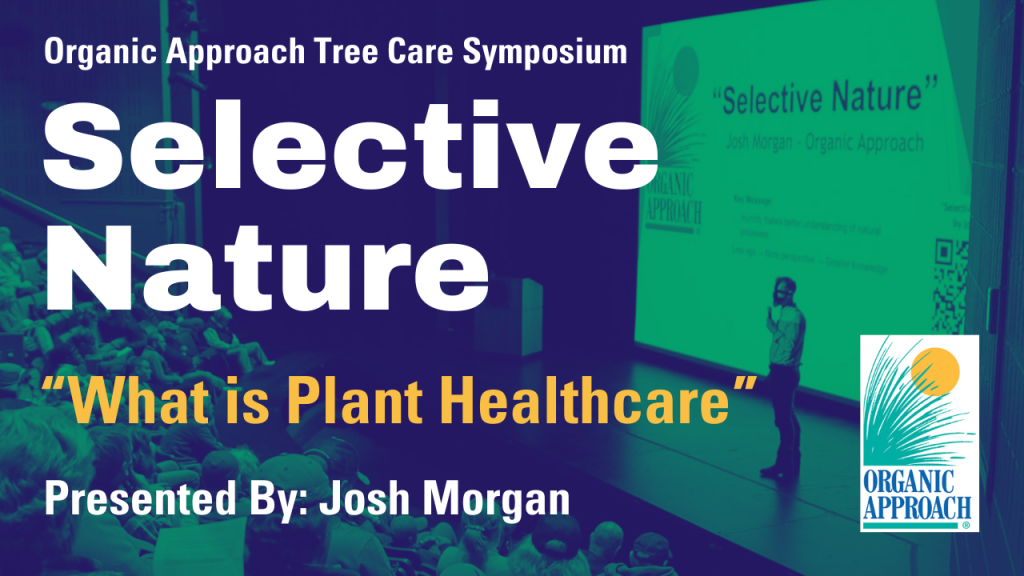- Plant Soil Heath
- 717-299-2112
- info@organicapproach.com
- Organic Approach Website
Josh’s Tree & Shrub Care Foundation Program
A Bundle of Sticks
September 29, 2021
3-Step Tree and Shrub Care
Provided by Organic Approach LLC – Lancaster, PA
It has come to my attention that it may be beneficial to put the basic skeleton of my plant health care program out to the world, so that anyone in the green industry who has the curiosity to digest it, may do so in any way they see fit. The intention here is simply to outline a basic structure, so that it may be adapted and customized to fit your clients’ needs or your own, in any variety of geographies or environmental conditions. This should not be seen as a “one-size fits-all” solution, but rather a strong foundation upon which to build your own program if you find that your requirements differ from mine. That having been said, I believe that this simple program will get you at least 80% of the way down the road with tree and shrub care, and many of the materials discussed can be just as easily adapted to any garden variety of growing needs with a little creativity and a willingness to get your hands dirty! Never hesitate to give us a call at Organic Approach if you have questions or problems, good service is what keeps us tied to our work.
A few “presuppositions”:
- Happy plants in good biological soils do not require constant fertilization.
- Happy plants in good biological soils have less pest/pathogen issues, requiring therefore less corrective chemical measures such herbicides, fungicides, insecticides, etc…
- Happy plants in good biological soils do not suffer stress to the same degree or magnitude as their unhappy counterparts in soils devoid of life and biological complexity.
These three ideas lead us to the conclusion that if we focus on the environment as much as we focus on the individual, we will achieve more sustainable long-term results in plant healthcare, requiring less maintenance, corrective measures and toxic chemicals, all while treating our stemmed friends and our planet in a way that would make us proud to hand these cherished resources down to future generations. The soil is the immune system of the plant- cultivate it!
If you are still reading, then we agree. Nice to have you on board.
As follows is my program for residential tree care. The materials and methods in this program can be adapted to create simple solutions for any number of green industry or homeowner requirements.
- I operate on a phenological year, not a calendar year, thus my season starts in March and ends in February (roughly speaking in regards to SE PA).
My program consists of on average, 3 seasonal high liquid volume stress reducer applications consisting of varying rates of biostimulant and organic nutrient packages, biological inoculum and beneficial microbial food substrates (Spring/Summer/Fall). These high-volume seasonal applications are the backbone of my program, and can be applied via soil injection, drench, or foliar spray dependent upon plant requirements and seasonal conditions. I run horticultural oils at higher rates during periods of plant dormancy (winter and early spring) to catch any egg masses of persistent nuisance pests, and at lower rates in late spring and early summer to avoid phytotoxicity and to catch larvae and juveniles I may have missed. I apply granular soil builders and bio-remediation materials in the fall, and I engage in cultural practice such as appropriate pruning and mulching (ideally with leaf compost!) throughout the growing season whenever is most strategic (or at the very least when my schedule allows or when requirements dictate I must). I make anti-transpirant applications in the winter to negate winter kill due to moisture loss from cold temperatures and winds, and I occasionally will take the similar materials out in the summer at much lower rates to negate drought stress from water loss if necessary.
The rest of this discussion will revolve around only my 3 seasonal “stress reducer” and fertilization high volume liquid applications, which again are the “backbone” of my plant health care practice. My tank mix and rates vary seasonally, but the foundation of every single tank mix I take into the field, no matter what season is Hyphalink Nourish. Nourish is a powerful biostimulant and stress reducing package. The product is 100% water soluble, ensuring easy mixing, good value, and lower shipping costs. Nourish makes all the other ingredients I may put in my tank work better, but it is a powerful agent in its own right, and there are certainly many instances and use cases where I would recommend using only Nourish and nothing else. 2lbs of dry Nourish powder makes 50-100 gallons of finished spray mix, and I challenge you to find a more versatile and affordable solution to your PHC (plant healthcare) needs.
Fall/Early Winter – Dormant Root Feed
Even though spring is when buds break and that’s when we think our season starts, I would challenge you to think about fall as a time to prepare for the coming growing season. This is the proverbial “squirrel gathering nuts before winter”. In my opinion, fall into early winter is the best time to engage heavy mechanical cultural practices (bed expansions, mulching [bonus points for leaf compost]), engage in some early dormant pruning, if necessary, before stems freeze (we want them to CUT not CRUNCH), and most importantly – DORMANT ROOT FEED. Soil biology is very active in late summer into fall, consuming and cycling dropped fruits and leaves from the annual senescence, and putting organic matter and nutrition back into the soil, to be digested and made bioavailable by spring for bud set and break. Why don’t we provide our heaviest rates of organic nutrition at this time (as well as high value carbon food substrates) so that we can better capitalize on the natural processes that are already occurring in the environment? Dormant root feeds are always soil injections in my program, because I want that value to go deep in the ground, to the roots, where it needs to be.
Dormant root feed tank mix:
Hyphalink Nourish – 2-4 lb / 100 gal
Encourage: 4-8 lb/ 100gal
and/or
FH 2-3-1 (Fish Hydrolysate) – 2-3 oz/gal
LC 10+7 (liquid humic acid concentrate w/ micronutrients) – 2 oz/gal
Therm-X Yucca – 1/5th oz/gal
Spring Stress Reducer/Fertilization
With the late fall Dormant Root Feed cooking in the ground over winter ready for bud break in spring, I don’t usually make my next full application round until after Tax Day. Late April and May are when I go out to complete my Spring Stress Reducers. This application usually has some organic fertility, but less than I run in Fall- I’m looking for a small bump to assist leaf expansion and hardening off, I’m not looking for Incredible Hulk growth. Spring applications are usually also completed as soil injections, although I may substitute some drenching for ornamentals and newer installations that do not have vast and deep root run.
Spring Stress Reducer/Fertilization mix:
Hyphalink Nourish (Substitute Nourish FE for acid loving plants)– 2-4 lb / 100 gal
Encourage: 4-6 lb/ 100gal
and/or
FH 2-3-1 (Fish Hydrolysate) – 1-2 oz/gal
LC 10+7 (liquid humic acid concentrate w/ micronutrients) – 2 oz/gal
Therm-X Yucca – 1/5th oz/gal
Summer Stress Reducer
Once the landscape has hardened off and we enter summer conditions, drought stress is my primary concern. Summer application season starts for me on Independence Day. I never want to “push” plants with fertility during periods of drought stress, because it is a wasteful drain on their precious energy reserves. Summer Stress Reducer applications are biology and metabolism focused. The objective is to provide plants with the supplements that they require to help them use their energy as efficiently as possible. Summer Stress Reducers are more often than not comprised of all foliar and drench work, or some combination of both. I want to get my material into the plant as quickly as possible, negating the patience required for translocation if I can. I will seldom, but occasionally incorporate a little bit of organic fertility or compost teas if seasonal conditions are friendly, but for the sake of discussion, my base mix is as follows-
Summer Stress Reducer Mix:
Hyphalink Nourish – 4 lb / 100 gal
Encourage: 2 lb/ 100gal
LC 10+7 (liquid humic acid concentrate w/ micronutrients) – 2 oz/gal
Therm-X Yucca – 1/5th oz/gal
To reiterate, this is what I would refer to as my “core” program. Rates can be tweaked and customized here and there to fit the requirements of any applicator. The essence, however, remains the same: The goal is to only provide strategic organic fertility when the plant needs it the most. All of our other work is focused on stress reducers and soil bioremediation, utilizing micronutrients, trace elements, complex organic carbon, biological food substrates, beneficial inoculum, and the list goes on.
We could expand on this core program in great detail if we were to discuss cultural practices, bio-rational pest control, extensive soil bioremediation and many other things. We will save those items for another day. There is a wealth of information available on our blog, plantsoilhealth.com, and many education videos on our youtube. All of the products outlined in this program are available at organicapproach.com. If any aspect of this piques your interest, don’t hesitate to call us, we’re here to help.
Josh Morgan
(717) 875-2470
Organic Approach
Organic Approach 3-Step Tree & Shrub Care Program Overview v1

